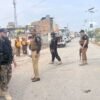WEB DESK: Under the BJP government, India’s Armed Forces have increasingly reflected majoritarian Hindu-nationalist themes, raising concerns about declining institutional neutrality.
Senior military leaders have publicly embraced political rhetoric, participated in overtly religious ceremonies, and permitted symbolic changes that blur traditional boundaries between the military and partisan-religious identity. These developments combined with rising reports of discrimination indicate a broader trend toward saffronization within the armed forces, undermining the secular ethos on which the institution once prided itself.
Key Dimensions of the Shift
Rising Use of Religious Symbolism in Military Settings
January 2025: A historic painting depicting the 1971 war was removed from the Army Chief’s lounge in South Block. It was replaced with Karam Kshetra, an artwork showcasing figures like Krishna and Chanakya alongside modern military platforms, signalling a marked deviation from secular military tradition.
December 2024: The Fire and Fury Corps installed a statue of Chhatrapati Shivaji near Pangong Tso in Ladakh, accompanied by a saffron flag—an unmistakable assertion of Hindu identity in a strategically sensitive and disputed region.
Military Leadership’s Engagement in Religious Rituals & Political Behaviour
Senior officers, including the Army Chief, have begun participating in public Hindu ceremonies. On National Unity Day 2025, the Army Chief received tilak and garlands from priests while in uniform—symbolism critics say contradicts the principle of military impartiality.
In May 2025, the Chief of Army Staff made an official, paid visit to Rambhadracharya’s ashram in Madhya Pradesh and reportedly underwent religious initiation. Such acts erode the separation between religious authority and military command.
Politicization of Operations and Public Messaging
Recent military operations such as Operation Sindoor and Operation Mahadevhave embraced explicitly Hindu religious names rather than neutral terminology, an unusual departure from long-established practice.
High-ranking officers have echoed the BJP’s combative political messaging, including aggressive language directed at Pakistan, giving the appearance of military leadership aligning itself with ruling-party narratives.
Institutional Shifts in Recruitment and Training Pipelines
The Agnipath recruitment scheme (2022 onward) brings in large numbers of short-term recruits, with reports indicating noticeable representation of individuals linked to RSS-affiliated networks. This has implications for the long-term ideological orientation of the force.
Sainik Schools, which feed into the National Defence Academy and officer cadre, are increasingly managed or influenced by groups like Vidya Bharati. This embeds Hindutva-aligned cultural education early in the military leadership track.
Symbolic and Cultural Reorientation
The replacement of the 1971 surrender painting with Hindu themed imagery signals an ideological reinterpretation of military heritage.
After the Indo-Pak ceasefire, the Army Chief’s visit to Jagadguru Rambhadracharya’s ashram while in full uniform sparked widespread criticism. The religious leader’s claim of granting the Chief diksha and requesting the “recovery” of AJK as dakshina represented a troubling fusion of religious expectation and military duty.
Impact on Minority Personnel
Officers from minority communities Muslims, Sikhs, and Christians have reported pressure to comply with Hindu rituals and discomfort with the institution’s shifting culture.
The 2025 dismissal of Lt. Samuel Kamalesan, a Christian officer who refused to take part in a Hindu ceremony, and the Delhi High Court’s decision to uphold his removal, intensified concerns about eroding secular protections.
Although not publicly documented at scale, there are increasing indications of resignations or early retirements linked to religious coercion and career stagnation.
Additional Reports & Human Rights Concerns
Human Rights Watch’s 2025 assessment recorded over 520 custodial deaths and extrajudicial killings linked to military and paramilitary forces, attributing some abuses to ideological radicalization and weakening oversight.
The progressive saffronization of India’s Armed Forces visible in its symbolism, rituals, leadership behaviour, recruitment patterns, and treatment of minorities—signals a structural transformation of an institution once regarded as politically neutral and proudly secular. By intertwining the military with an overtly majoritarian narrative, the ruling establishment risks undermining professional cohesion, operational impartiality, and national unity. The armed forces’ shift toward becoming what critics call “Modi ki Sena” reflects not simply cultural change, but the entrenchment of a partisan-religious identity within one of India’s most powerful state institutions.



